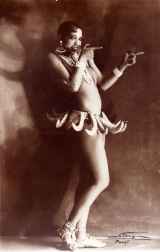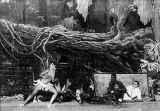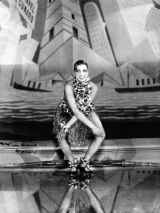Embracing “The Other” in Josephine Baker
Western culture has created a wide variety of “others” that derive from erroneous stereotypes. Whether these constructions are based on race, religion or sex, we condemn them for being ignorant and wrong. Edward Said (1935-2003) wrote that Western culture has constructed their notion of far-Eastern cultures (or “the other”) as a mix of inaccurate cultural representations instead of one based in actual reality (Said 1979). These notions and subsequent inaccurate representations of the of locations such as Asia, Africa and the Middle East have been socially constructed to fit Western society’s anxieties and fears regarding “the other.” They have also been used by Western European countries to justify colonization, which took place from about the 16th century to the mid 20th century. However, what are we to do when confronted with someone who perpetuates his or her own stereotype of “the other” for personal gain? How are we to react? Performer Josephine Baker is an example of exactly this type of dilemma.

Baker was born Freda Josephine McDonald in St. Louis, Missouri in 1906. Born to a poor family, she spent much of her childhood as a housekeeper and babysitter for rich white families (Louck and Haberman). When she was older, Baker enjoyed moderate success as a performer in the United States until she arrived in Paris in the 1920s where she was almost an overnight sensation with her fascinating dancing and singing in Jazz-style productions. Jazz was a new import to Paris and her dancing was something the Parisian audience had never seen before. She danced in almost no clothes, and in many performances wore only a skirt made of feathers or bananas. She performed wild, slightly erotic, even comically uninhibited routines that also included new dance crazes such as the Charleston. While Baker had no formal training, apart from the social and popular dances she learned in vaudeville troupes in the US, she emulated dances of “primitive” cultures such as African, Afro-Caribbean and others that she had seen performed. By doing this, Baker adopted the role of the “native wild woman,” even though she had never been to the places whose culture she claimed to be a part of through her onstage character (Louck and Haberman).
She enjoyed incredible fame in Paris and became known as the most photographed woman in the world, even inspiring other artists, as seen in Paul Colin’s famous Art Deco posters. The poster entitled Le Tumulte Noir (Black Thunder) from 1929, and others by Colin embody the spirit of the “roaring twenties” culture that was all-the-rage in Paris at the time. The poster and other works like it show the social acceptance of black performers such as Baker in Paris, acceptance that she could not have found in the US. For example, in 1936 Baker briefly returned to the US to expand her career. She received horrible reviews from audiences and critics who were appalled by the self-confident African American woman’s act (Louck and Haberman).
Baker used a combination of the erotic and comic to enhance the African stereotype that she gave her onstage persona. Essentially, Baker was creating a characterized version of “the other” through her eroticization of the African female. There are two ways that we can look at this example. One option is to view Baker’s actions negatively due to the fact that even though she was herself black, she was still creating a negative, exaggerated image of Africans and black people in general. Josephine constructed an image of the black woman as a carnal being who could not be tamed. This woman was so “primal” that what little clothes she did wear were made of materials such as bananas and feathers that could be found in her native jungle. Such was the image that Josephine transmitted to the public. She did not present a true performance of authentic African dance since she had never studied it nor even visited the African continent.

Inherent in the West’s interpretation of “the other” is the idea of its members being “tribal” or “primitive” beings. This immediately brings to mind the derogatory notion of a culture that is stuck in the past, unable to grow or advance (Minor 209). It suggests that this “other” culture is not part of the progressive and educated society known in the West. This includes a tendency that Western audiences had to associate “primitive” cultures with naiveté and unsophistication due to the primitive’s assumed simplistic nature. Writing in the 1930s, around the time of Baker’s fame, Robert Goldwater came to the conclusion that modern artists of the time embraced “primitivism” in modern art because they thought that the more visually simplistic a work was, the more profound (Minor 210). This is based on the assumption that the “native” being exists in an innocent and undeveloped state. The “native” is untainted by the modern, Western world and is therefore considered pure and uncorrupted.
Like the modern artists that Goldwater wrote about, Josephine Baker also integrates the idea of the pure, simple native into the construction of her onstage character. Her dancing was free-flowing and unconcerned with aspects of form or style. Baker’s audiences’ negative assumptions about the “primitive” may lead us as modern-day readers to the conclusion that Baker’s actions were misguided and only furthered negative stereotypes. After all, Paul Colin’s posters of Josephine testify to the fact that she had a great impact on the society in which she lived. Colin’s posters were made as advertisements for Baker’s shows and were widely distributed. His work continued to promote the idea of the “wild African” because a large public, including those who did not attend Baker’s performances, would have viewed the posters.
However, we can consider Baker’s onstage career in a different way if we keep in mind that she was the one benefiting from her actions. Baker experienced an extremely successful career because she saw her opportunity in Paris and took it. She experienced the kind of fame and wealth that would never have been possible for her without the onstage character she created. Some might even say that she was reclaiming the stereotype that had already been placed on her by society. After all, she was not the inventor of the African stereotype she used in her performances. From before the time of Baker’s career, minstrel shows had been performing in the United States for years. Shows like these were made for a white American audience that was raised with racism and segregation. These shows included many racist stereotypes that Baker encountered in her early career. Many of the shows she performed in both American and Paris had stereotypical names such as “The Chocolate Dandies”, “Runnin’ Wild” and the “danse sauvage” (Gates and Dalton 911). In one show, Baker was dressed in clown shoes with black face makeup, to make her face even darker and further satirize her character. Baker merely played to the Parisian audiences’ preconceived perceptions of the colonized “other” (Pratt Guterl 26).
The constructed stereotype of the wild, naive African was already in existence and Baker simply took it and manipulated it to fit her own agenda, one that can be viewed as satire. Baker could have been intentionally satirizing the African native in order to target the wider Parisian audience who was familiar with the stereotype. After all, other artists such as artist Paul Colin were also creating work that perpetuated this African stereotype. Colin’s other posters include images of performers in black face makeup with exaggerated red lips. Whenever Colin portrayed a black woman in his posters, she was shown in exaggerated dance poses similar to the image of Baker in the banana skirt. Colin sometimes even included African animals in the posters, even if the animals were never included in the depicted performer’s shows. In this sense, Baker’s Paris shows can be seen as the reclaiming of a negative stereotype.

The only problem with this view however, is that even if Baker did “reclaim” this stereotype, she did not do anything new or profound with it to make it worthy of reclaiming. She did not try to shed a new light on the stereotype, or make people see the error in it. Instead, she simply perpetuated it and if anything, made it an even more acceptable opinion of the “other” by giving it her consent as a performer. It should be noted however, that although Baker never received any formal African or Afro-Caribbean dance training, she greatly admired those who did, especially Katherine Dunham, an African American dancer and anthropologist. Baker noted that Dunham “knew everything about Africa and more important, understood it” (Baker and Bouillon 164). Baker also noted that she would have liked to learn African languages and customs but never had the time (Baker and Bouillon 193).
I can only imagine that Baker, an extremely intelligent woman, would have realized the contradictions of her actions and the injustice of the age she lived in. This dilemma is hard to come to a solid conclusion, especially given the fact that later in her life Baker was an extremely important part of the civil rights movement in the United States in the 1950s and 60s (Louck and Haberman). In fact, from reading her memoirs, it seems that throughout her life Baker was always trying to fight for civil rights and equality. Perhaps we can never reach a solid consensus regarding Baker’s career choices. Was she wrong or right or something in between? It seems that like parts of Baker’s life, this question of identity is full of contradictions.
Work Sited
Baker, Josephine, and Jo Bouillon. Josephine. New York: Harper & Row, 1977.
Gates, Jr. Henry Louis, and Karen C.C. Dalton. “Josephine Baker and Paul Colin: African American Dance Seen through Parisian Eyes.” Critical Inquiry 24 (1998): 903-934.
Louck, Tracie, and Barbara Haberman. “The Official Josephine Baker Website.” CMG Worldwide, n.d. Web. 2 Mar. 2012. <www.cmgww.com/stars/baker/index.php>.
Minor, Vernon Hyde. Art History’s History. 2nd Ed. Englewood Cliffs, N.J.: Prentice Hall, 2001.
Pratt Guterl, Matthew. “Josephine Baker’s Colonial Pastiche.” Black Camera 1 (2010): 25-37.
Said, Edward W. Orientalism. New York: Vintage Books, 1979.
What do you think? Leave a comment.











I find it interesting that she was so pivotal to the Civil Rights movement when she was essentially satirizing herself. I wonder if this can fall in line with “reclaiming” or not…Otherwise I love the article =]
I am currently in an African-American history class; this week I am writing about Josephine Baker. Glad to have this as a reference.
I’m so glad I could help! Good look on your paper.
When I was young, I saw some old film clips of her and I was fascinated by her, she was mesmerizing that’s for sure. There use to be a show that came on, “That’s Entertainment” and if my memory is correct, I think they did a show on her. I was really mad when I saw her story because American audiences rejected her. She was a lady, so beautiful and way before her time.
Love your article. I use Josephine Baker in my history of photography course as a connection between artists such as Maya Deren, Claude Cahun, Cindy Sherman and Yasumasa Morimura and Nikki S. Lee.
“Instead, she simply perpetuated it and if anything, made it an even more acceptable opinion of the “other” by giving it her consent as a performer.”
This is a great line. Well done.
There is a rumour that Baker was under consideration by a Hollywood studio in the 1930s to play Bess opposite Paul Robeson in a film version of Porgy and Bess, but nothing concrete has come to light. It is possible this project may have been discussed around the time Josephine appeared on Broadway in the Ziegfeld Follies in the mid-1930s. This would have been about the same time Robeson was in Hollywood making Show Boat (1936). It would be great if this rumour could be substantiated. Hollis Alpert’s book Porgy and Bess – The Story of an American Classic doesn’t mention anything about the rumoured film, only that Robeson was considered for the 1935 stage version of the Gershwin folk opera. For information on a Baker contemporary (they were featured together on stage in The Chocolate Dandies in 1924) read Stephen Bourne’s biography Elisabeth Welch – Soft Lights and Sweet Music (Scarecrow Press, 2005). In the 1930s, shortly after Baker made her French films, Welch co-starred with Paul Robeson in Big Fella (1937), playing a cafe singer in Marseilles. Not as flamboyant or extrovert as Baker, Welch is nonetheless an important Black diva of the era. She is also another example of how European cinema of the 1930s offered starring roles to Black women (and other ‘ethnic’ women, such as Anna May Wong) which they were denied in Hollywood.
Thanks for the book suggestion, I had never heard that rumor before.
She was wonderful.
Really cool article! I’ve never heard of Josephine Baker until now but she seems mad interesting. I find all these contradictions fascinating. Well done!
She is very beautiful and she knew how to GLAM it up for the cameras!
It always suprises me that more people haven’t heard of her.
She was a powerful performer. I liked your article very much, and agree with the idea that on one side she was re-enforcing the stereotype of the “savage” other, but on the other profiting from it. She created a success for herself that was unheard of for a woman, let alone a woman of color. Such a fascinating artist. Very smart.
You did a really nice job of fairly weighing the apparently contradictory interpretations of Josephine Baker’s stage persona. She was truly a fascinating individual, as your article highlights.
In deed Ms. Baker may have had to do what she had to do to make it, but she made it at least in Paris. Women are still experiencing the role of “The Other,” for example Madonna, used sexual exploitation to get her to fame and fortune. She did not let “others” exploit her, she did the exploitation herself and she reaped the rewards. It is unfortunate that women cannot be who they really are sexual beings without all the negative and offensive labels.
I respect Baker for being such a successful, independent, and fearless woman especially for her time period. Other strong artists such as Rihanna and Beyonce have payed homage to Josephine Baker through adapting her banana skirt or taking inspiration from her other characteristic looks. Other artists have even recreating famous pictures of her, posing in similar positions with similar outfits and lighting. She reclaimed the views of primitive black culture by being so wildly successful, resourceful, fearless, and inspirational for writers, performers, and artists even today.
She may have satirized herself to make something positive – fame, riches – out of the negative – racism, false stereotypes. She gave the audience what they wanted and then laughed at their idiocy as the money poured in. Or she may have been under the wrong impression about African culture herself, being that she was American. So, she felt wild and free and had fun with this role as the wild primitive jungle woman; it was all just a performance she enjoyed. But I doubt she deliberately or knowingly portrayed herself in a way that she felt would tear down her own race, particularly since she was so involved with civil rights.
You might want to look at Matthew Pratt Guterl’s just published book, Josephine Baker and the Rainbow Tribe. Also, correct your ref to his article: last name is Guterl, not Pratt.
What I like about the Josephine Baker story, is that she is complex and doesn’t always do what is considered moral or proper. In other words, she is a real girl.
Black women have been stereotyped as bodies for the performance of physical labor. Labor extends to the sexualization of these bodies. Baker is cognizant of this fact and exaggerates the stereotype of race and sexuality. Her involvement in the Civil Rights movement is also paradoxical, as women were often sidelined to the male leaders.
What leaves me wondering is the question of artistic intent. If Baker’s intent was to reclaim the stereotype placed on her by the dominant white culture by performing the “primitive” character, does it matter whether or not her audience understands that she is deliberately projecting a caricature? I have researched her before and think she’s a pretty amazing performer, but the question still lingers in my head as to whether or not her audience got that she was performing satire. If they didn’t understand that key part of her art, then she isn’t doing anyone any favors by profiting from their amusement of this racist stereotype. Then again, she made do with the resources she had a seized an opportunity that wasn’t afforded most black women, so who could blame her?
You develop an interesting comparison of the different ways to interpret Baker’s actions. It begs the question of how much emphasis we place upon peoples’ actions in the past, especially those in the limelight. Whereas Baker could have been reclaiming her stereotype to present it in a manner that empowered her or perpetuated/validated the social perceptions of the ‘other,’ she also could have simply been a young woman attempting to carve her mark in the fabric of history. I wonder if we were placed in her position, if we would attempt to radically change a perception that had existed for centuries or be more concerned with sources of income and financial support. Perhaps Baker did not consider the ramifications of her provocative performances and was truly content with her success and ability to thrive in a profession that she was passionate about. It would be intriguing to read more of her writing and possible interviews to gain a better understanding of her awareness of the ramifications her actions had.
Thank you for this thought-provoking article!